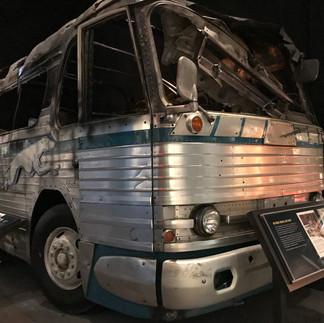National Civil Rights Museum: the most moving place in Memphis
- Austin Coop
- Jan 5, 2022
- 3 min read
On April 4, 1968, a gunshot cracks in downtown Memphis, TN, and the world loses Martin Luther King Jr. on the balcony of the Lorraine Motel. Once a resting place frequented by civil rights leaders and famous musicians such as Otis Redding, the motel instead becomes a symbol of tragedy and racial strife. Today, however, the National Civil Rights Museum takes the Lorraine Motel and uses it to teach us about the past in hopes of a better tomorrow. Let’s take a look around one of the most moving places we’ve visited…
Outside the National Civil Rights Museum
When you walk up to the Lorraine Motel, you’re transported back to 1968 and can immediately feel the gravity of where you are. The museum has restored the front of the museum to look just as it would have on the day Martin Luther King Jr. was assassinated, down to the vintage cars parked outside and the Lorraine Motel sign.

A simple wreath where he was standing and a tasteful plaque honor MLK Jr., and it’s hard not to feel emotional as you stand and imagine the scene on that fateful day in April.

Once you’ve taken in the outside of the museum, it’s time for an immersive journey through the inside of the museum’s two main buildings.
Inside the National Civil Rights Museum
Once inside the main building, visitors self-guide themselves through the history of the civil rights movement in the United States with permanent exhibits ranging from the history of slavery to the Montgomery bus boycott to the Freedom Riders and beyond. After experiencing the main building, visitors can also tour the “Legacy Building” across the street, where James Earl Ray is thought to have fired his fatal shot.

From the NCRM:
"The museum offers 260 artifacts, more than 40 new films, oral histories, interactive media and external listening posts that guide visitors through five centuries of history — from the beginning of the resistance during slavery, through the Civil War and Reconstruction, the rise of Jim Crow, and the seminal events of the late 20th century that inspired people around the world to stand up for equality."
The museum, of course, also has a permanent exhibit highlighting the very reason why MLK Jr. was in Memphis- the sanitation worker strike. Step back in time to feel the tensions present in Memphis in the spring of 1968 before finally viewing MLK Jr.’s room as it would have been the day he was assassinated.

While the museum brings to life the history of the civil rights movement, it also looks ahead with exhibits aimed at engaging us in the current issues of social justice and civil rights we face as a country and world.
Overall, it’s one of a handful of museums in the United States that flawlessly educates and inspires at the same time. For us, it’s one of the must-see places in Memphis, if not the entire country.
Visiting the National Civil Rights Museum
The museum has ample parking and is located just a short drive or walk from the hustle and bustle of Beale St. Admission is $18, but they do offer multiple discounts/free passes for seniors, veterans, and children. Visit their website for more information.
If you’d like to visit the NCRM and all the other great Memphis hotspots, consider joining us on one of our Southern Car Caravans from Nashville to New Orleans.
Other Memphis articles from Two Lane America:






























